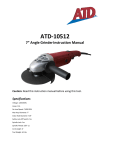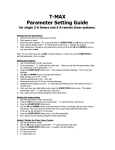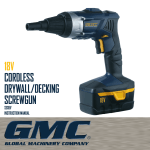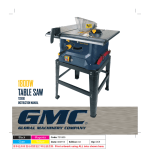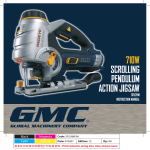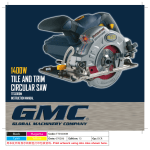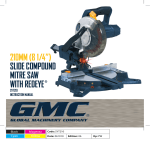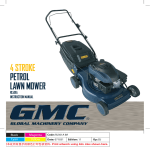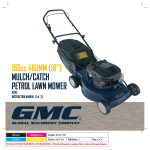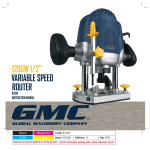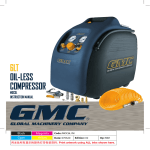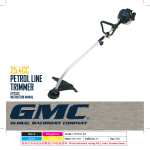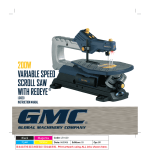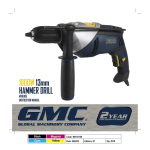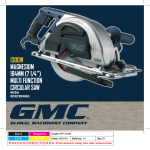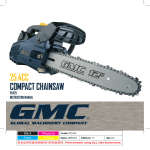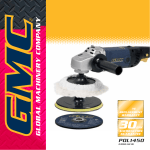Download Global Machinery Company POL1450M User's Manual
Transcript
Contents Warranty 2 Warranty Power Tools Introduction 3 Environmental protection 3 Description of symbols 3 Specifications 3 Safety instructions 4 Additional safety rules for angle grinders 5 Additional safety rules for sanders 6 Additional safety rules for polishers 7 Accessories 7 Unpacking 7 Know your product 8 Setting up 9 Variable speed 9 Operation in grinder mode 9 Operation in sander mode 11 Operation in polisher mode 12 Replacing the rubber disc 13 Maintenance 13 Cleaning 13 General inspection 13 Whilst every effort is made to ensure your complete satisfaction with this tool, occasionally, due to the mass manufacturing techniques, a tool may not live up to our required level of performance and you may need the assistance of our service department. This product is warranted for a 2-year period for home domestic use from the date of the original purchase. If found to be defective in materials or workmanship, the tool or the offending faulty component will be repaired or replaced free of charge with another of the same item. A small freight charge may apply. Proof of purchase is essential. We reserve the right to reject any claim where the purchase cannot be verified. This warranty does not include damage or defects to the tool caused by or resulting from abuse, accidents, alterations or commercial or business use. It also does not cover any bonus items or included accessories. Only the power tool is covered under this warranty. With continuing product development, changes may have occurred which render the product received slightly different to that shown in this instruction manual. Please ensure that you store your receipt in a safe place. Conditions apply to the above warranty. For full details of the warranty terms and conditions please refer to our website – www.gmcompany.com For prompt service we suggest you log your service request online - www.gmcservice.com.au, should you not have access to the internet, please contact our service department on 1300 880 001 (Australia) or 0800 445 721 (New Zealand). 2 Introduction Description of symbols Your new GMC power tool will more than satisfy your expectations. It has been manufactured under stringent GMC Quality Standards to meet superior performance criteria. You will find your new tool easy and safe to operate, and, with proper care, it will give you many years of dependable service. CAUTION. Carefully read through this entire Instruction Manual before using your new GMC Power Tool. Take special care to heed the Cautions and Warnings. Your GMC power tool has many features that will make your job faster and easier. Safety, performance, and dependability have been given top priority in the development of this tool, making it easy to maintain and operate. The rating plate on your tool may show symbols. These represent important information about the product or instructions on its use. Wear hearing protection. Wear eye protection. Wear breathing protection. Double insulated for additional protection. Nominal voltage: 230–240Vac ~ 50Hz Environmental protection Input power: 1450W No Load Speed: 1500–6500 RPM Insulation class: Double Insulated Disc size: 180mm Spindle: 15.88mm (M14) Conforms to relevant standards for electromagnetic compatibility. Specifications Recycle unwanted materials instead of disposing of them as waste. All tools, hoses and packaging should be sorted, taken to the local recycling centre and disposed of in an environmentally safe way. 3 a. Stay alert, watch what you are doing and use common sense when operating a power tool. Do not use a power tool while you are tired or under the influence of drugs, alcohol or medication. A moment of inattention while operating power tools may result in serious personal injury. b. Use safety equipment. Always wear eye protection. Safety equipment such as dust mask, non-skid safety shoes, hard hat, or hearing protection used for appropriate conditions will reduce personal injuries. c. Avoid accidental starting. Ensure the switch is in the off position before plugging in. Carrying power tools with your finger on the switch or plugging in power tools that have the switch on invites accidents. d. Remove any adjusting key or wrench before turning the power tool on. A wrench or a key left attached to a rotating part of the power tool may result in personal injury. e. Do not overreach. Keep proper footing and balance at all times. This enables better control of the power tool in unexpected situations. f. Dress properly. Do not wear loose clothing or jewellery. Keep your hair, clothing and gloves away from moving parts. Loose clothes, jewellery or long hair can be caught in moving parts. g. If devices are provided for the connection of dust extraction and collection facilities, ensure these are connected and properly used. Use of these devices can reduce dust related hazards. General safety rules WARNING. Read all instructions. Failure to follow all instructions listed below may result in electric shock, fire and/or serious injury. The term “power tool” in all of the warnings listed below refers to your mains operated (corded) power tool or battery operated (cordless) power tool. Save these instructions 1. Work area a. Keep work area clean and well lit. Cluttered and dark areas invite accidents. b. Do not operate power tools in explosive atmospheres, such as in the presence of flammable liquids, gases or dust. Power tools create sparks which may ignite the dust or fumes. c. Keep children and bystanders away while operating a power tool. Distractions can cause you to lose control. 2. Electrical safety a. Power tool plugs must match the outlet. Never modify the plug in any way. Do not use any adapter plugs with earthed (grounded) power tools. Unmodified plugs and matching outlets will reduce risk of electric shock. b. Avoid body contact with earthed or grounded surfaces such as pipes, radiators, ranges and refrigerators. There is an increased risk of electric shock if your body is earthed or grounded. c. Do not expose power tools to rain or wet conditions. Water entering a power tool will increase the risk of electric shock. d. Do not abuse the cord. Never use the cord for carrying, pulling or unplugging the power tool. Keep cord away from heat, oil, sharp edges or moving parts. Damaged or entangled cords increase the risk of electric shock. e. When operating a power tool outdoors, use an extension cord suitable for outdoor use. Use of a cord suitable for outdoor use reduces the risk of electric shock. 3. Personal safety 4 4. Power tool use and care Additional safety rules for angle grinders a. Do not force the power tool. Use the correct power tool for your application. The correct power tool will do the job better and safer at the rate for which it was designed. b. Do not use the power tool if the switch does not turn it on and off. Any power tool that cannot be controlled with the switch is dangerous and must be repaired. c. Disconnect the plug from the power source before making any adjustments, changing accessories, or storing power tools. Such preventive safety measures reduce the risk of starting the power tool accidentally. d. Store idle power tools out of the reach of children and do not allow persons unfamiliar with the power tool or these instructions to operate the power tool. Power tools are dangerous in the hands of untrained users. e. Maintain power tools. Check for misalignment or binding of moving parts, breakage of parts and any other condition that may affect the power tools operation. If damaged, have the power tool repaired before use. Many accidents are caused by poorly maintained power tools. f. Keep cutting tools sharp and clean. Properly maintained cutting tools with sharp cutting edges are less likely to bind and are easier to control. g. Use the power tool, accessories and tool bits etc., in accordance with these instructions and in the manner intended for the particular type of power tool, taking into account the working conditions and the work to be performed. Use of the power tool for operations different from those intended could result in a hazardous situation. a) This power tool is intended to function as a grinder, sanding, polishing or cut-off tool. Read all safety warnings, instructions, illustrations and specifications provided with this power tool. Failure to follow all instructions listed below may result in electric shock, fire and/or serious injury. b) Operations such as wire brushing are not recommended to be performed with this power tool. Operations for which the power tool was not designed may create a hazard and cause personal injury. c) Do not use accessories which are not specifically designed and recommended by the tool manufacturer. Just because the accessory can be attached to your power tool, it does not assure safe operation. d) The rated speed of the accessory must be at least equal to the maximum speed marked on the power tool. Accessories running faster than their rated speed can break and fly apart. e) The outside diameter and the thickness of your accessory must be within the capacity rating on your power tool. Incorrectly sized accessories cannot be adequately guarded or controlled. f) The arbour size of wheels, flanges, backing pads or any other accessory must properly fit the spindle of the power tool. Accessories with arbour holes that do not match the mounting hardware of the power tool will run out of balance, vibrate excessively and may cause loss of control. g) Do not use a damaged accessory. Before each use inspect the accessory such as abrasive wheels for chips and cracks, backing pad for cracks, tear or excess wear, wire brush for loose or cracked wires. If power tool or accessory is dropped, inspect for damage or install an undamaged accessory. After inspecting and installing an accessory, position yourself and bystanders away from the plane of the rotating accessory and run the 5. Service a. Have your power tool serviced by a qualified repair person using only identical replacement parts. This will ensure that the safety of the power tool is maintained. 5 power tool at maximum no-load speed for one minute. Damaged accessories will normally break apart during this test time. h) Wear personal protective equipment. Depending on application, use face shield, safety goggles or safety glasses. As appropriate, wear dusk mask, hearing protectors, gloves and workshop apron capable of stopping small abrasive or workpiece fragments. The eye protection must be capable of stopping flying debris generated by various operations. The dust mask or respirator must be capable of filtrating particles generated by your operation. Prolonged exposure to high intensity noise may cause hearing loss. i) Keep bystanders a safe distance away from work area. Anyone entering the work area must wear personal protective equipment. Fragments of workpiece or of a broken accessory may fly away and cause injury beyond immediate area of operation. j) Hold power tool by insulated gripping surfaces only, when performing an operation where the cutting accessory may contact hidden wiring or its own cord. Cutting accessory contacting a "live" wire may make exposed metal parts of the power tool "live" and shock the operator. k) Position the cord clear of the spinning accessory. If you lose control, the cord may be cut or snagged and your hand or arm may be pulled into the spinning accessory. l) Never lay the power tool down until the accessory has come to a complete stop. The spinning accessory may grab the surface and pull the power tool out of your control. m)Do not run the power tool while carrying it at your side. Accidental contact with the spinning accessory could snag your clothing, pulling the accessory into your body. n) Regularly clean the power tool's air vents. The motor's fan will draw the dust inside the housing and excessive accumulation of powdered metal may cause electrical hazards. o) Do not operate the power tool near flammable materials. Sparks could ignite these materials. p) Do not use accessories that require liquid coolants. Using water or other liquid coolants may result in electrocution or shock. Kickback and related warnings 6 Kickback is a sudden reaction to a pinched or snagged rotating wheel, backing pad, brush or any other accessory. Pinching or snagging causes rapid stalling of the rotating accessory which in turn causes the uncontrolled power tool to be forced in the direction opposite of the accessory's rotation at the point of the binding. For example, if an abrasive wheel is snagged or pinched by the workpiece, the edge of the wheel that is entering into the pinch point can dig into the surface of the material causing the wheel to climb out or kick out. The wheel may either jump toward or away from the operator, depending on direction of the wheel's movement at the point of pinching. Abrasive wheels may also break under these conditions. Kickback is the result of power tool misuse and/or incorrect operating procedures or conditions and can be avoided by taking proper precautions as given below. a) Maintain a firm grip on the power tool and position your body and arm to allow you to resist kickback forces. Always use auxiliary handle, if provided, for maximum control over kickback or torque reaction during start-up. The operator can control torque reactions or kickback forces, if proper precautions are taken. b) Never place your hand near the rotating accessory. Accessory may kickback over your hand. c) Do not position your body in the area where power tool will move if kickback occurs. Kickback will propel the tool in direction opposite to the wheel's movement at the point of snagging. d) Use special care when working corners, sharp edges etc. Avoid bouncing and snagging the accessory. Corners, sharp edges or bouncing have a tendency to snag the rotating accessory and cause loss of control or kickback. e) Do not attach a saw chain woodcarving blade or toothed saw blade. Such blades create frequent kickback and loss of control. Safety warnings specific for polishing operations: a) Do not allow any loose portion of the polishing bonnet or its attachment strings to spin freely. Tuck away or trim any loose attachment strings. Loose and spinning attachment strings can entangle your finger or snag on the workpiece. Safety warnings specific for grinding and abrasive cutting-off operations a) Use only wheel types that are recommended for your power tool and the specific guard designed for the selected wheel. Wheels for which the power tool was not designed can not be adequately guarded and are unsafe. b) The guard must be securely attached to the power tool and positioned for maximum safety, so the least amount of wheel is exposed towards the operator. The guard helps to protect operator from broken wheel fragments and accidental contact with wheel. c) Wheels must be used only for recommended applications. For example: do not grind with the side of cut-off wheel. Abrasive cut-off wheels are intend for peripheral grinding, side forces applied to these wheels may cause them to shatter. d) Always use undamaged wheel flanges that are of correct size and shape for your selected wheel. Proper wheel flanges support the wheel thus reducing the possibility of wheel breakage. Flanges for cut-off wheels may be different from grinding wheel flanges. e) Do not use worn down wheels from larger power tools. Wheel intended for larger power tool is not suitable for the higher speed of a smaller tool and may burst. Accessories The GMC POL1450M Grinder/Sander/Polisher is supplied with the following accessories as standard: • Side handle • Metal grinding disc • Disc guard • Polishing sponge • Polishing bonnet • Rubber disc • Sanding disc • Pin wrench • Allen key Unpacking Due to modern mass production techniques, it is unlikely that your GMC Power Tool is faulty or that a part is missing. If you find anything wrong, do not operate the tool until the parts have been replaced or the fault has been rectified. Failure to do so could result in serious personal injury. Safety warnings specific for sanding operations a) Do not use excessively oversized sanding disc paper. Follow manufacturers recommendations, when selecting sanding paper. Larger sanding paper extending beyond the sanding pad presents a laceration hazard and may cause snagging, tearing of the disc or kickback. 7 Know your product Before using the polisher, familiarise yourself with all the operating features and safety requirements. Use the tool and accessories only for the applications intended. All other applications are expressly ruled out. 1. Motor housing 2. Spindle lock button 3. Variable speed dial 4. Rear handle 5. Soft grip 6. Mounting points for the multi position front handle 7. On/Off switch 8. Lock-off button 9. Multi-position front handle 10. Rubber disc 11. Polishing sponge 12. Polishing bonnet 13. Sanding disc 14. Grinding disc 15. Disc guard 16. Inner flange 17. Outer flange 8 must always be facing the operator. 2. Insert the guard securing screw and tighten using the matching nut. Use the supplied Allen key to securely tighten the screw. 3. Place the inner flange (16) onto the spindle making sure it fits securely. 4. Ensure that the non-threaded inner flange is on the spindle and located correctly. The two machined flat sections on the inner flange must face the angle grinder and locate in the matching positions on the spindle. 5. Place the grinding or cutting disc on top of the inner flange ensuring the bore fits into the raised centre section of the flange. Setting up Multi position front handle Screw the multi position front handle (9) into the most suitable mounting point (6) (left side, right side or at the top) to suit the task on hand. Variable Speed The POL1450M is fitted with a variable speed dial (3) that allows you to adjust the speed to suit the application and material. The tool operates between the speeds of 1500 RPM – 6500 RPM, the higher the number on the variable speed dial, the higher the speed. For polishing and buffing applications it is recommended that a lower speed (1500 RPM) is used. For sanding applications it is recommended that a medium speed (3500 RPM) is used to provide efficient material removal, for grinding applications the maximum speed (6500 RPM) should be selected. WARNING. Do not operate the machine with a polishing bonnet attached above 1500 RPM (Position 1 on the variable speed dial). Operation in grinder mode 6. Place the outer flange (17) over the spindle. For grinding and cutting discs which are 5mm or thicker, fit the outer locking flange (17) with the raised centre section inwards towards the wheel. This helps to locate the disc on the flanges. 7. For grinding and cutting discs which are less than 5mm in thickness, fit the outer locking flange with the raised centre section facing outwards, away from the disc. 8. Failure to fit the outer flange correctly as detailed above will result in the outer flange tightening on the inner flange but not clamping the disc. Fitting the grinding disc Switch off the tool and disconnect it from the power supply. WARNING. The guard must always be attached and secured to the tool during angle grinding applications. 1. Fit the guard (15) onto the spindle collar and rotate to the required working position. The closed side of the guard 9 3. Allow the grinder to start and attain full speed before bringing the disc to the work piece. 4. To prevent a new grinding disc from digging into the work piece, first draw the grinder across the work piece towards the operator. Once the leading edge of the disc is slightly worn down, grinding can be conducted in either direction. 5. Once the grinding or cutting is finished, remove the disc from the work piece. To turn the tool off, release the on/ off trigger switch. The lock-off button (8) will re-engage. 6. The tool will stop. (Please note that the disc continues to spin for a few seconds even though the switch is turned off). Keep hands well away from the moving disc. Do not place the tool down until the grinder has come to a complete stop. 9. To tighten, press and hold the spindle lock button (2) and using the pin wrench tighten the outer flange. 10. Turn the new disc by hand, ensuring that it is tight in the flanges and that it rotates fully and does not wobble unduly. 11. Run the angle grinder at no load for at least one minute to ensure the new disc is in good condition. Make sure you are wearing all the safety gear and that you face the grinder away from you. Holding and guiding the tool 1. Always clamp the work piece. 2. Do not overload the tool so that the disc slows down. Let the tool do the work rather than applying pressure. The weight of the tool alone provides sufficient pressure. 3. Cutting discs become very hot when in use. Take care not to touch them until they have cooled down. 4. Hold the tool securely and make sure that you have full control at all times. 5. During a cutting operation, maintain an angle of 30 to 40 degrees between the tool and the work piece. 6. During grinding, maintain an angle of 15 to 30 degrees between the tool and the work piece. Switching on and off Before starting the grinder, first ensure the disc, guarding and the tool is in good condition. Plug the cordset into the mains socket and set up for the task to be performed. WARNING. Ensure you are wearing safety glasses. 1. Hold the tool firmly in anticipation of the start up torque. 2. Press and hold the lock-off button (8) and squeeze the on/off trigger switch (7). Note. Once the tool has started there is no need to maintain pressure on the lock-off button. Operation in sander mode Fitting the Sandpaper Switch off the tool and disconnect it from the power supply. 1. The GMC grinder/sander/polisher is fitted with a hook & loop base allowing easy changing of accessories. Ensure there are no debris left in the hooks & loops of the disc before fitting accessories. 10 2. Align the sandpaper with the rubber disc and press down firmly to ensure a good grip. 3. Special care must be taken with Hook & Loop platens, as a build up of dust, or wearing the sandpaper down completely before changing it, can result in damage to the hooks & loops on the platen and require a new platen to be fitted. Note. Hook & Loop platens are not a warranty item. 2. To start the tool, depress the lock-off button (8) and squeeze the on/off trigger switch (7). Note. Once the tool has started there is no need to maintain pressure on the lock-off button. 3. Do not overload the tool so that the disc slows down. Let the tool do the work rather than applying pressure. The weight of the tool alone provides sufficient pressure. 4. After completing the application, turn the sander off. To turn the tool off let go of the on/off trigger switch (7). The lock-off button (8) will re-engage. The tool will stop. (Please note that the disc continues to spin for a few seconds even though the switch is turned off). Keep hands well away from the moving disc. Wait until the disc stops rotating before lifting the grinder/sander/polisher from the surface. Selecting the right grade of sandpaper 1. Different grades of sandpaper can be purchased from your local hardware store. 2. Typical grades are coarse (40–60 grit), medium (80–100 grit), and fine (120–240 grit). 3. Use coarse grade to remove rough finishes, medium grade to smooth the work, and fine grade to finish it off. 4. It is best to make a trial run on a scrap piece of material to determine the optimum grades of sandpaper for a particular job. Holding and guiding the tool 1. Always clamp the work piece where applicable. 2. Before starting the tool, first ensure the rubber disc, sanding disc and the tool are in good condition. Plug the cordset into the mains socket. 3. Do not overload the tool so that the disc slows down. Let the tool do the work rather than applying pressure. The weight of the tool alone provides sufficient pressure. 4. Hold the tool securely and make sure that you have full control at all times. 5. During the sanding operation, maintain an angle of 10–15 degrees between the tool and the work piece. Switching on and off IMPORTANT. When the product is being used for sanding only use speed settings between 1 and 3. Never use speed setting greater than position 3. 1. To start the tool, first ensure the rubber disc, sanding disc and tool are in good condition. Plug the cordset into the mains socket. Operation in polisher mode Prepare the surface For best results, the surface should be clean and dry. Most high-gloss surfaces can be cleaned with a mild soap and water solution. For removal of stubborn dirt stains such as road tar, grease, and bug stains, you can use a mild ammonia solution such as that used in glass cleaners. Before using any cleaning product, check the label for recommended applications and follow the directions for use. Never apply cleaner directly onto surface to be polished. 11 Apply to a clean cloth and then use the cloth to clean the surface. Do not use any type of abrasive cleanser as it may damage or scratch the surface. 2. To start the tool, depress the lock-off button (8) and squeeze the on/off trigger switch (7). Note. Once the tool has started there is no need to maintain pressure on the lock-off button. Fitting the bonnets 1. Your GMC grinder/sander/polisher comes with a polishing bonnet. The polishing bonnet is used for buffing and finishing the surface. 2. To fit the polishing sponge, press and hold the spindle lock button (2) and screw the polishing sponge onto the spindle. 3. The polishing bonnet features a drawstring attachment to fit the bonnet over the polishing sponge. 4. Place the bonnet over the polishing sponge so that the outer edge can be drawn over the top of the disc. 5. Carefully tighten the drawstring around the polishing sponge and secure it with a simple overhand knot. 6. Tuck the drawstring into the bonnet. 7. Remove the bonnet by loosening the drawstring and slipping the bonnet off the polishing sponge. 3. Do not overload the tool so that the disc slows down. Let the tool do the work rather than applying pressure. The weight of the tool alone provides sufficient pressure. 4. After completing the application, turn the polisher off. To turn the tool off let go of the on/off trigger switch (7). The lock-off button (8) will re-engage. The tool will stop. (Please note that the disc continues to spin for a few seconds even though the switch is turned off). Keep hands well away from the moving disc. Wait until the disc stops rotating before lifting the grinder/ sander/polisher from the surface. Holding and guiding the tool 1. Always clamp the work piece where applicable. 2. Before starting the tool, first ensure the polishing sponge, polishing bonnet and the tool are in good condition. Plug the cordset into the mains socket. 3. Do not overload the tool so that the disc slows down. Let the tool do the work rather than applying pressure. The weight of the tool alone provides sufficient pressure. 4. Hold the tool securely and make sure that you have full control at all times. 5. During the buffing operation, maintain an angle of 15–20 degrees between the tool and the work piece. Applying polish Most polishes are either in paste or liquid form. Before using any polish read all directions on appropriate applications and proper use. Switching on and off IMPORTANT. When in polishing mode set the variable control to the slowest speed (position 1) for the best result. Never faster. 1. To start the tool, first ensure the disc and tool are in good condition. Plug the cordset into the mains socket. 12 3. Re-lubricate all moving parts at regular intervals. 4. Never use caustic agents to clean plastic parts. CAUTION. Do not use cleaning agents to clean the plastic parts of the tool. A mild detergent on a damp cloth is recommended. Water must never come into contact with the tool. Replacing the rubber disc Switch off the grinder/sander/polisher and disconnect it from the power supply. 1. The polishing sponge and rubber disc are fitted with a quick disc release system meaning that no tools are required. To remove the disc, press and hold the spindle lock button (2) and unscrew the disc from the spindle. Note that the disc unscrews in an anti-clockwise direction. 2. Remove the disc. 3. Check the new disc. 4. Fit the new disc onto the spindle and screw it on in a clockwise direction. Turn the new disc by hand, ensuring that it is tight on the spindle and that it rotates fully and does not wobble unduly. 5. Run the grinder/sander/polisher at no load for at least one minute to ensure the new disc is in good condition. Make sure you are wearing all the safety gear and that you face the polisher away from you. General inspection Regularly check that all the fixing screws are tight. They may vibrate loose over time. Maintenance All the bearings are sealed ball bearings, lubricated for life, and require no maintenance. Power cord maintenance If the supply cord needs replacing, the task must be carried out by the manufacturer, the manufacturer's agent, or an authorised service centre in order to avoid a safety hazard. Cleaning 1. Keep the tool’s air vents unclogged and clean at all times. 2. Remove dust and dirt regularly. Cleaning is best done with a rag. Wear safety goggles or an eye shield and gloves whist cleaning. 13 14 15 GMC customer assist If your product needs repairing, replacing, technical service or you simply need help or advice, please contact us on our Customer Assist Line 1300 880 001 (Australia) or 0800 445 721 (New Zealand). For prompt service we suggest you log your service request online at www.gmcservice.com.au. Should you not have access to the Internet, please contact our service department on 1300 880 001 (Australia) or 0800 445 721 (New Zealand). 7am – 7pm, 7days a week (AEST). Please note that if repair or replacement is required, you must provide a valid original purchase receipt. You will need the following details at hand to log your service request; Personal details: First & Last name, address, pick up address, contact phone numbers, email address Product details: Product number, date of purchase, retailer bought from, State & postcode, receipt number, reason for the request, copy of official purchase receipt Attach your purchase receipt and save with this Manual for future reference. Please refer to our website www.gmcompany.com for full GMC warranty Terms and Conditions.

















